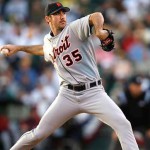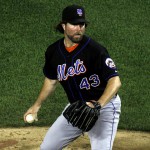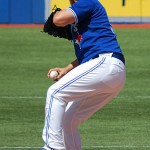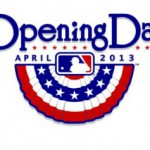My standard disclaimer; this is a whole huge post kvetching about my 2013 Fantasy Baseball team. If you don’t play fantasy, feel free to skip this 3,000 word missive. I’ll insert a “jump” line here so that RSS readers don’t have to see this whole massive post 🙂
Archive for the ‘ra dickey’ tag
More R.A. Dickey Animated Gifs
A few months ago I posted a Youtube video showing a Catcher’s point-of-view look at R.A. Dickey‘s knuckle ball coming in.
Here’s a couple more cool graphics that have popped up on various blogs that I read.
- From imgur/r/baseball, an animated Gif of Dickey’s knuckler as it travels to the plate. Done by the same fellow @DShep25 who did similar Gifs of Yu Darvish‘s repertoire and of Miguel Cabrera‘s ability to hit homers from any point in terms of plate coverage. (h/t to BusinessInsider blog).
- And here’s a story to go with the above images from the author himself, Drew Shephard on fangraphs.com.
Still amazing that his 2013 numbers are so bad right now (6-8, 4.90 ERA, 1.388 whip, all significantly worse than his Cy Young numbers from last year). The Blue Jays are only 6-9 in his starts, a big reason why they’re in last place in the AL East right now.
And then, since its related to these cool graphics, here’s a study (again from BusinessInsider’s Sports blog) about the Physics of a Curve Ball. Its no wonder Dickey reportedly didn’t even travel with the team when they went to Colorado; he knew his pitches wouldn’t have any movement.
A forkball after my own heart
Thanks to Rob Neyer for this article, posted 5/16/13 (and subsequently Jeff Passan in this 5/28/13 article and this Ted Berg USAToday article on 5/29/13) about Robert Coello, a journeyman hurler currently with the Los Angeles Angels who throws what one executive calls a “Knuckle-Forkball” but what in reality is an “Original Forkball.” Not a “Split Fingered Fastball” mind you, but a true-on Forkball. Neyer then goes into some research he did with Bill James on the pitch and has a pretty interesting history on this very rare pitch.
Neyer’s post has video of the pitch as it comes out of his hand (as does the Usatoday article) and indeed the ball knuckles and dives like a knuckler. He only threw one forkball in his 5/15/13 outing but has thrown more than a few since and is getting some national media notice.
Here’s Pitch F/X data for Coello’s 5/15/13 outing. They classified this pitch as a “FS,” pitch f/x lingo for “Fastball-Split” or a splitter. He threw it at 79.5mph. Since then, he’s thrown (I guess) 11 more Forkballs (now classified in Pitch F/X as a “FO”) at an average of 79.2mph. By way of comparison, R.A. Dickey‘s average knuckleball velocity in 2013 has been 75.3mph. And Dickey’s knuckleball is considered so effective because he throws it with such pace (Tim Wakefield only threw his 65-66mph for the last few years of his career). Imagine if Coello can command this pitch and throw it consistently and frequently; he’d have a chance of combining a Dickey-esque fast knuckleball with his 91mph fastball. That could be quite a combination.
So, why is this guy so interesting to me? Because in my own abbreviated amateur baseball pitching career, I threw the same pitch! Somehow over the years screwing around while warming up as a middle infielder I discovered this pitch; you jam the baseball between your index and middle fingers and then throw the ball such that it “pops” out of your hand (it will even make a popping noise, not unlike a soft snapping fingers noise) and begins knuckling towards its target. It definitely is not a diving/sinking split fingered fastball motion; it knuckles in. You can throw it with some pace; you throw it with the same motion and intensity as a fastball, except that it gets hung up in the webbing of your fingers and knuckles out. It is relatively easy to control, especially if you throw over the top and just “aim” the ball at the middle of the plate. I used it as a 3rd pitch but one outing in particular it was moving so much that my catcher called nothing but forkballs.
I always called it a forkball, but figured it knuckled instead of diving down like a typical split-fingered fastball because I wasn’t throwing it at the pace of a professional pitcher. Now as it turns out, it looks like I was just throwing a “throw back” pitch rarely seen in the professional ranks. Cool.
This world needs more Forkball pitchers!
Post-post update: Fangraphs Eno Sarris had a great article on him 9/23/13, showing multiple gifs of the pitch, as well as noting that Coello now has a top-30 wFB pitch thanks to the uniqueness of the forkball.
R.A. Dickey and his “Nasty Pitch” on 60 Minutes Sports
R.A. Dickey and his knuckleball were featured on 60 Minutes Sports last month and we just got around to watching it off the DVR. If you missed it, the full segment is available online at cbsnews.com via this link.
Now, we’re not talking very in-depth reporting here (Lesley Stahl is the reporter, not exactly known for doing heavy hitting pieces), but the parts about Dickey and the physics of the knuckleball are fun. They talk about Dickey’s “dark past” in the intro but I don’t recall them going into it (you can read his wiki page for a quick summary). They interview a couple of university researchers who specialize in physics and engineering and demonstrate some cool stuff about the knuckler. They interview Phil Neikro. And of course Dickey himself is a good interview, though they don’t really go that deep into his life or his pursuits.
One funny bit that I learned from the piece: Dickey wouldn’t even join the team when they went to Colorado because he knew the thinner air there destroyed his knuckler. Makes sense to me; when you see the knuckler in the wind-tunnel on the piece, its fascinating to see how the air particles move around the ball. Also funny was the time that Dickey had to run across the street from Shea stadium to get a “korean nail salon” to work on his hand after he tore/broke a nail on the mound; he apparently literally ran over there in full uniform straight out of the stadium.
Anyway; good quick watch.
MLB 2013 Predictions
Opening day has past and I forgot to post the obligatory “predictions” piece for 2013. Here’s some far-too-early predictions on who makes the playoffs this year. For comparison purposes. here’s the Si.com Writer’s slate of predictions, with lots of success predicted for our Nats. My predictions below look awfully similar to Si.com’s Baseball Preview standings too.
(For a trip down memory lane, here’s a link to my 2012 seasonal predictions, and as you may have guessed, I was way off).
- AL East: Tampa Bay
- AL Central: Detroit
- AL West: Los Angeles Angels
- AL Wild Cards: Toronto, Oakland
AL East Narrative: The year the Yankees died; they’re too old, too dependent on aging arms and aging bats, and did next to nothing to improve in the off-season (though they did just pick up Vernon Wells, the Angels’ 4th outfielder. Great!) For a team that makes hundreds of millions of dollars of profits a year from the stadium and their TV station, they seem awfully worried about a few million dollars of luxury tax. (see *ahem* Los Angeles Dodgers *cough*). I think Baltimore regresses back to the .500 team they should have been in 2012 (they too failed to appreciably improve their playoff team), and Boston seems stuck in some weird middle-ground for the time being. Toronto seems greatly improved but falls slightly short of the champ. Tampa is left standing in the AL East; they won’t miss James Shields that much with their amazing pitching depth and can call up the next version of Trout/Harper in Wil Myers in mid June.
In the AL Central, Kansas City’s short sighted trade will net them a .500 record, but isn’t nearly enough to catch the Tigers, who return their whole rotation, get back Victor Martinez and add a possibly underrated Torii Hunter to add to their formidable lineup. How they only won 88 games last year still amazes me. The White Sox could challenge, but what have they really done this off-season either? On the bright side, all these teams get to feast on Cleveland and Minnesota, both of whom look to lose 90+ games.
In the AL West, the Angels (who had the best record in baseball post Trout-callup) continue where they left off and bash their way to a 90 win divisional title despite serious questions in the rotation. Texas hasn’t replaced what they lost in the last two off-seasons in terms of either hitting (Josh Hamilton) or pitching (C.J. Wilson, Ryan Dempster, or Colby Lewis) but should still compete for the 2nd wild card. But, absent signing Kyle Lohse (too late; he went to Milwaukee) or doing something to augment their starting pitching, I see trouble in the back of their rotation. Meanwhile, Seattle made one curious move after another this off-season, all to finish in 4th place. And Houston will challenge the 1962 Mets for futility, to the benefit of the entire division.
Wild Cards: Toronto has bought themselves a playoff team with their wholesale purchase of half the Marlins team. However, I wouldn’t be surprised to see both WCs come out of the AL west, who get to feast on two pretty bad teams. For the time being i’ll predict that Oakland and Texas duke it out to the wire, with Oakland pipping them for yet another surprise playoff appearance. Oakland won the division last year; who would doubt them again this year with a very young pitching staff having one additional year of experience? I think it comes at the expense of Texas this year instead of the Angels.
How about the NL?
- NL East: Washington
- NL Central: Cincinnati
- NL West: San Francisco
- NL Wild Cards: Atlanta, St. Louis
NL East Narrative: Despite some people thinking that Atlanta has done enough to get by the Nats, I don’t quite see it. The Upton brothers are high on potential but so far relatively low in actual production except in fits and spurts. Philadelphia can make a decent run up to perhaps 88 wins … but it won’t be enough, and reports of Roy Halladay‘s declining velocity are more than troubling. Meanwhile the Marlins are going to be historically bad; in the past when they’ve done sell-offs they had marquee crops of rookies to rise up. Not this time; their farm system is decimated and they didn’t really get back the A-1 prospects of all their salary dumps that they should have. The only way the Nats don’t cruise to a title would be significant injuries in the rotation, for which they have little insurance.
In the NL Central, St. Louis’ loss of Chris Carpenter may be just enough to knock them out of the divisional race, where Cincinnati looks like the most complete team outside of the Nats in all of baseball. Pittsburgh is a couple years (and a couple of pitching aces in Jamison Taillon and Gerrit Cole) away from really competing, the Cubs are content losing 95 games, and Milwaukee still looks like the same team that barely was .500 last year (even given the Kyle Lohse signing).
In the NL West; who would bet against the Giants at this point? Despite the ridiculous payroll, I don’t think the Dodgers are really that good and they’re hoarding starting pitchers for too few spots (though, looking at the Spring Training performance of some of these guys … they’ll likely not fetch what the Dodgers need). Arizona keeps trading away its best players to get marginal prospects who happen to fit Kirk Gibson‘s mold of a “gritty player” … and they seem to be set to be a 3rd place team again. Colorado and San Diego seem to be in various states of disarray, again.
Wild Cards: Atlanta may be a 96 win wild card. Meanwhile, despite losing Carpenter the Cardinals can slot in any one of a number of high-powered arms to replace him in the rotation and continue to draw from what is now the consensus best farm system in the majors. They’ll sneak into the wild card much as they did last year and commence bashing their way through the playoffs.
AL Playoff predictions:
- WC play-in: Toronto beats out Oakland, whose youngsters will be completely baffled in a one-game playoff versus R.A. Dickey.
- Divisionals: Toronto beats intra-divisional rival Tampa Bay, while Detroit takes advantage of a weakened Los Angeles rotation and takes a close series.
- ALCS: Detroit outlasts Toronto in the ALCS on the strenght of its starting pitching.
NL Playoff predictions
- WC play-in: Atlanta beats St. Louis in the play-in by NOT allowing an infield-fly pop up to fall in this year.
- Divisionals: Washington outlasts Atlanta in one brutal divisional series, Cincinnati gets revenge on San Francisco in the other.
- NLCS: Washington over Cincinnati; they’re just slightly better on both sides of the ball.
World Series: Washington’s proclivities to strike out come back to haunt them as the Tigers excellent starting pitchers dominate. Can’t be too confident in our Nats; i’d love to be wrong and send out Davey Johnson a winner.
Awards: this is just folly to do pre-season awards picks but here’s a quick run through without much commentary:
- AL MVP: Mike Trout gets the award he should have won last year
- AL Cy Young: Justin Verlander as he wins 24 games in the weak AL Central
- AL Rookie; Wil Myers, who rakes once he gets called up in June
- AL Manager: Joe Madden, who guides Tampa to the best record in the AL.
- NL MVP: Joey Votto, though I wouldn’t be surprised to see Bryce Harper in the mix either as the default “best player on a playoff team” voting scheme takes over.
- NL Cy Young: Stephen Strasburg, who won’t have as good of numbers as Clayton Kershaw but gets the nod because of east coast bias.
- NL Rookie: Jedd Gyorko, though Julio Teheran could finally have it figured out.
- NL Manager; I have no idea; this usually just goes to the most “surprising” team and I don’t see many surprises in the NL this year. Bruce Bochy.
Opening Day Starter Trivia
One of my favorite annual trivia questions amongst my baseball buddies revolves around Opening Day Starters. With another Opening Day in the books, here’s some useless trivia related to Opening Day starters for my readers. I’ve uploaded my little Opening Day Starters spreadsheet to Google Docs and created a link in the “Nationals Arm Race creation” section along the right.
Current Active Leaders in Opening Day Starts
| 10 | Roy Halladay |
| 10 | CC Sabathia |
| 9 | Mark Buehrle |
| 6 | Bartolo Colon |
| 6 | Derek Lowe |
| 6 | Tim Hudson |
| 6 | Felix Hernandez |
| 6 | Justin Verlander |
| 5 | Aaron Harang |
| 5 | Josh Beckett |
| 5 | Jered Weaver |
| 5 | James Shields |
| 4 | Jake Peavy |
| 4 | Barry Zito |
| 4 | Tim Lincecum |
| 4 | Yovani Gallardo |
Those players bolded in the list above had 2013 opening day starts and added to their totals. Roy Halladay‘s difficult spring training cost him his shot at Opening Day and thus CC Sabathia moves into a tie for first. Mark Buehrle has given over the reigns of opening day starter possibly for good, based on his standing in the Toronto rotation (4th starter?).
Felix Hernandez and Justin Verlander have chances to broach the all-time records (see below) based on their ages, their current counts and their new long-term contracts.
Current Active Leader in consecutive Opening Day Starts: Verlander with 6 straight.
Most ever Opening Day Starts all-time: Tom Seaver with 16 in his career.
Most ever Consecutive Opening Day Starts: Hall of Fame lightning rod Jack Morris, who made 14 straight such starts.
Number of first-time opening day starters in 2013: no less than 13 first timers this year, nearly half the league. Some guys got deserved first-time opening day starts (Jeff Samardzija, Matt Cain, and R.A. Dickey), some guys got Opening Day starts mostly out of attrition of other worthy pitchers (Jon Niese, Bud Norris, A.J. Burnett, Vance Worley and Jhoulys Chacin) and some guys are taking over as the new big-dog of their rotations (Brett Anderson, Chris Sale).
Who seems most likely to break Seaver’s Record at this point? Sabathia, who already has 10 opening day starts, is clearly the #1 in New York, is only 32 and still has five years on his current deal. Question is, if he renews past 2017, can he still earn the #1 spot? Meanwhile Hernandez already has 6, just signed a deal that takes him through 2019 with a relatively easy option for 2020. That’s 8 more seasons on his existing 6 opening day starts and he’d only be 34 years of age. He could be the standard holder if he stays healthy and continues to pitch like an ace.
My 2013 Fantasy Baseball Team
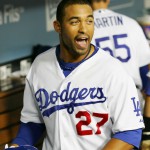
Kemp reacts to being Boss' first round pick in my fantasy league for the 2nd year running. Photo unknown via ladodgertalk.com
Editor’s note: feel free to stop reading now if you don’t want to read 4,400+ words on my fantasy baseball team. I won’t blame you for it. For those of you who do play fantasy, as I made picks I wrote down who I was considering and who was available per each pick to try to give some context for the pick. I’ll insert a “jump” line here so that RSS readers don’t have to see this whole massive post 🙂
Starting Pitching Quality in the WBC
I keep a little file, periodically updated, that keeps track of “Ace Starters” in the league. There’s usually right around 20 of them at any one time. There’s no hard and fast rule as to what defines an Ace; not every team has an Ace. Some teams have more than one Ace. Its essentially defined as a guy who, every time he goes to the hill, he is expected to win, a perennial Cy Young candidate, a guy who is acknowledged as being one of the best in the game.
Here’s my list of “Aces” in this league, right now; Strasburg, Gonzalez, Halladay, Lee, Hamels, Cueto, Wainwright, Lincecum, Cain, Kershaw, Greinke, Lester, Price, Sabathia, Dickey, Johnson, Verlander, Hernandez, Darvish and Weaver. Twenty guys, some arguable with poor 2012 performances (Lester, Lincecum, Johnson, Halladay), some arguable for possibly being one-year wonders (Dickey, Greinke, Gonzalez), but by and large a quick list of the 20 best starters in the league.
How many of these Aces are pitching in the 2013 WBC? TWO. That’s it. Gio Gonzalez and R.A. Dickey are starting for the US. Not one other US Ace is taking the hill for their country. The few foreign guys (Hernandez, Cueto and Darvish) aren’t pitching for their teams either for various reasons.
If you asked me to give you the 4 best US starters, right now, the four starters I’d throw in a World Baseball Classic to best represent this country, I’d probably go (in nearly this order) Verlander, Kershaw, Strasburg and maybe Cole Hamels. If you asked me the NEXT four guys i’d want on the bump i’d probably go Sabathia, Cain, Price and Lee. After that? I’d probably still take the likes of Halladay and Greinke before I got to Gonzalez or Dickey. And that’s only because of the poor 2012 showings by Lincecum, Lester and Johnson; if this was 2011, those three guys are absolutely in the mix for best arms in the league. So by rough estimates, we have perhaps the 14th and 15th best American starters going for us right now.
Who else does the US team have starting? Ryan Vogelsong and Derek Holland. Vogelsong is the 4th best starter ON HIS OWN TEAM, and Holland isn’t much further up on the Texas depth chart.
I’m enjoying the WBC, don’t get me wrong, but you can repeat this exercise for a number of the positional players on this roster too. Look at the post-season voting last year and look at who is playing on these teams. No Buster Posey, Mike Trout, Bryce Harper, Andrew McCutchen, Josh Hamilton or Prince Fielder. There is only one player who got an NL Cy Young vote in 2012 participating (Fernando Rodney for the D.R.). I think this event needs its best players to play, and I think the league needs to come up with a way of making that happen. No more injury dispensations, no more excuses for not having the best, most marketable guys out there.
Why in the hell aren’t Trout and Harper playing for the team USA?? This is the best duo of young, marketable players to this this league since the 1998 home run derby. They’re on the cover of Men’s Health Magazine and Sports Illustrated in the last month. You use what you have and market the league on the backs of players like this. Look at the NBA; they market on top of their most recognizable names and they have grown because of it, from Michael Jordan to Kobe Bryant to LeBron James. Why MLB can’t seem to see the forest for the trees sometimes is just frustrating. The WBC is growing in popularity; its ratings in Japan eclipsed the TV ratings for the Olympics in that country, and the US games reportedly have gotten the highest ratings for a non-playoff game in TV history). Team USA needs to catch on.
R.A. Dickey’s knuckleball POV style
From Dirk Hayhurst‘s blog (whose books you should absolutely order; they’re good reading), here’s a 1:35 minute video of R.A. Dickey‘s knuckleball being shot from directly over the shoulder of his bullpen catcher.
Serious question; how do you possibly hit this? He throws it in excess of 80mph and it moves this violently? Amazing. Its no wonder he won the Cy Young last year, and I can’t see him being appreciably different in 2013.
Stats Overview Part II: Hitting stats on the rise: wRC, wOBA, etc
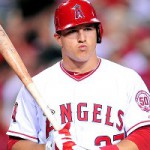
Trout's BABIP was very high in 2012; what does this mean for 2013? Photo Gary Vasquez/US Presswire via espn.com
(Part 2 in a series: Part 1 talked about Whats Wrong with Old School Baseball Stats).
More and more in modern baseball writing, you see relatively new statistical creations thrown into articles in order to prove or disprove an opinion, and more and more you almost need a glossary to properly read these articles and properly understand what the author is attempting to say. I always want to understand that which I read, and at the same time I want to make sure I stay current and up-to-date on the stats out there, so I decided to do a little research (and pen my own post while I was at it) into some of these newer stats that are being used.
I’ll write about each stat, give links to its calculation, write about how it may be used, then put in some rules of thumb by which to consider the stat.
Pretty much every stat here is defined and available at either Baseball-reference.com or fangraphs.com. BaseballProspectus.com also has some more obscure stats discussed further below. I’ve always thought that B-R’s interface was so much easier to navigate that I tend to search there first, but a more complete set of stats is at fangraphs.
1. BABIP. Batting Average on Balls in Play. Most people know this one, but it is an important stat to consider in conjunction with other stats (especially the older Batting Average and Earned Run Average). The calculation, as it is seen at Wikipedia, measures basically how many balls put into play (removing from consideration home runs) turned into hits. Interestingly it penalizes the hitter for hitting sacrifice flies (not sure why). This stat is kept for both individual hitters and for pitchers.
How is BABIP used? The measurement is essentially used as a checkpoint for fluky seasons. If a pitcher has a very high ERA but also has a very high BABIP, one can explain that he’s been unlucky and his talent level lays somewhere below his posted performance on the year. Ironically, the two leaders of Pitcher BABIP in 2012 were both on the Tigers; Rick Porcello and Max Scherzer had BABIPs of .344 and .333 respectively; this delta is probably going to lead to both of these guys having better ERAs in 2013. If a hitter has a decent hitting season but also has a high BABIP, one usually says that the hitter was “lucky” and is due to regress (Mike Trout in 2012 had a Babip of .383. That’s really high, probably unsustainably high, and he probably regresses statistically in 2013).
MLB Average/Rule of thumb: .290-.300 depending on the year.
When BABIP is high: a hitter is considered to be “lucky,” and future regression of more batted balls being turned into outs is expected.
When BABIP is low, a hitter is considered to be “unlucky,” and future improvement of more hits on batted balls is expected.
Caveats using BABIP: there are many arguments about whether some pitchers “baseline BABIP” should be modified based on their talent or capabilites. For example, Mariano Rivera‘s career BABIP is .262 while R.A. Dickey‘s BABIP since he turned into a Mets knuckleballing starter is around .275. Rivera’s lower baseline is probably attributed to his amazing cutter and his pure skill, while Dickey’s is most likely due to the fluctuations of hitting his knuckleball. Meanwhile, some hitters maintain higher than average career BABIPs (two extreme examples that immediately come to mind are Ichiro Suzuki and Nyjer Morgan, with career BABIPs of .347 and .336 respectively. Why so high? Because both are skilled at bunting (or at least hitting choppy grounders) for base hits, artificially inflating their baseline BABIP.
2. ISO; Isolated Power. As posted on Wiki, Isolated power can be simply calculated by subtracting a hitter’s batting average from the slugging percentage, or as it is more eloquently defined at FanGraphs, ISO is essentially a measure of how many extra base hits a batter hits per at-bat. Slugging tells you how many bases per at bat a hitter obtains, but ISO strips out singles to isolate a player’s capability of hitting doubles, triples and homers. Here’s a couple of decent examples from 2012; our own Bryce Harper hits a ton of extra base hits; he’s posted a .206 ISO for the 2012 season. Meanwhile we know that the aforementioned Nyjer Morgan is not a very powerful hitter and ISO shows it; he’s at .069 for the 2012 season. The league leaders for ISO reads like a list of MLB’s best sluggers. Giancarlo Stanton would have led the league in ISO had he qualified; he posted a fantastic .318 ISO in 2012.
How is it used? ISO is used to measure how good a hitter is at getting extra-base hits.
MLB Average/Rule of thumb (from Fangraphs page) .145 is considered an “average” MLB ISO figure. .200 is pretty good, .100 is poor.
Caveats using ISO: as with many sabremetric-tinged stats, small sample sizes greatly skew the figures. Fangraphs says 550 ABs is needed before really drawing any judgements.
3. wOBA; Weighted On Base Average. Created by Tom Tango, wOBA is a relatively newer statistic that attempts to improve upon the traditional batting statistics we use (Batting Average, Slugging and On Base Percentage) by measuring cumulative “weighted” hits that a batter may achieve. It is based on the premise that the three traditional stats just mentioned all treat hitting events relatively the same. Is a single equal to a double? No, but in Batting Average it is. Is a double worth half as much as a home-run? No, but in the Slugging Percentage it is. Each hitting event is weighted and added together, with increases/decreases for stolen bases/caught stealing thrown in, to arrive at a measurement that attempts to better quantify pure hitting.
How is it used? wOBA attempts to be set to the same scale as the league wide OBP, which seems to hover around .315-.320 year to year.
MLB Average/Rule of thumb (from Fangraphs page) .320 is a good “league average” number. .370 is great, .300 is poor.
Caveats using wOBA: There are several to keep in mind; the weights change year to year, in order to normalize the stat across generations. It is NOT normalized to park factors, so hitters in places like Boston and Colorado will have artificially inflated wOBAs to their true value. Lastly, there’s zero context given to the game situation when measuring hits (i.e. was there a guy on third with one out? Was it a close game in the 9th?) I think particular situation is nearly impossible to measure in any stat, but it is important.
4. RC/wRC: Runs Created and Weighted Runs Created. Runs Created is a stat that Bill James invented in one of his earlier Baseball Abstracts (1985) in order to try to measure simply how many runs an individual player contributed to the team in a given season. It was improved upon vastly in 2002 to be much more detailed and accurate; the original version over-emphasized some factors of hitting. It is a complicated statistic (see its wiki page for the formula). The aforementioned Tom Tango improved upon the basic RC by creating the Weighted version of the statistic based on his own Weighted OBA statistic (which he believed more closely measures the proper “value” of each hitting event).
How is it used? Individually, RC and wRC need to be understood in context of an entire season. It isn’t until we get to wRC+ (see below) that a side-by-side comparison is capable. Its like saying “Player X has 105 hits.” If that’s through 75 games, that’s pretty good; if that’s for an entire season, well that’s pretty poor.
MLB Average/Rule of thumb (from Fangraphs page) RC and wRC both have roughly the same scales. 60 is average, 100 is great, 50 is poor for a full season.
Caveats using RC and wRC: They are basically full season counting numbers. In 2012, Trout started in the minors, so his RC and wRC totals are less than his MVP competition Miguel Cabrera.
5. wRC+/wRAA: Weighted Runs Created Plus/Weighted Runs Above Average
wRAA and especially wRC+ are touted by fangraphs.com as being very good “single number” statistics to properly measure a player’s hitting ability. I often use OPS+ as a singular number to measure a hitter; fangraphs specifically calls out this number and recommends using wRC+.
How is it used? Both numbers basically measure the same thing. wRC+ is a bit easier to explain; 100 is the league baseline, and points above or below the average are expressed as “percentage points above or below the league average.” So, a person with a 120 wRC+ is considered to be 20% better at creating runs than the average major leaguer. Cabrera and Trout ironically tied for the MLB lead for 2012 in wRC+, each posting a 166 wRC+. Meanwhile wRAA (per fangraphs.com) “measures the number of offensive runs a player contributes to their team compared to the average player” and is scaled to zero. wRAA is essentially a direct calculation from wOBA, so if you’re using one you can likely ignore the other.
MLB Average/Rule of thumb (from Fangraphs page) for wRC+: 100 is average while for wRAA zero (0) is average. 20-25 percentage points above is great, while 15-20 percentage points below is bad.
Caveats for using: Unlike wOBA, wRC+ is park- and league-adjusted, indeed making it an excellent single number by which to measure players. Otherwise the caveats for these weighted averages are all about the same; they seem to be based on an weighting of hits that you may or may not agree with.
What have I learned from looking into these hitting stats? I need to keep BABIP in mind. I like ISO but I don’t see it gaining real credence over slugging percentage. And I should probably start using wRC+ more than OPS+.
Part 3 coming up on Pitching advanced stats.
